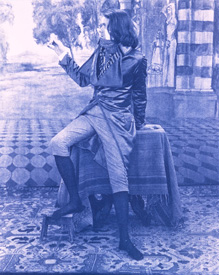
November 22 - January 25, 2003 |
McDERMOTT & McGOUGH
|
A HISTORY OF PHOTOGRAPHY
|
galerie jerome de noirmont
|

exhibition release
From November 22, 2002 to January 25, 2003, the Galerie Jérome de Noirmont will present a retrospective of the Photographic Work of MacDermott & MacGough, with more than one hundred original photographs. During the Parisian "Mois de la Photo 2002", this very important exhibition will show, in the spirit of a "cabinet d´amateur", the extreme quality of the timeless work of these American artists, who always complete their photographs with techniques from the pioneers of the nineteenth century.
Born in 1952 and 1958, MacDermott & MacGough met in the early 80s in New York. Integrating quickly into the New York artistic scene side by side with such artists as Andy Warhol, Jean-Michel Basquiat and Julian Schnabel, they nevertheless remain completely alien to the aestheticism and daily cosmos of their contemporaries. Refusing to subscribe to the "biblical theory of linear time" and therefore to let themselves be shut into the contemporary setting of time, MacDermott & MacGough break its boundaries and reject the principal of chronological divisibility: they consider that all times exist within the same time. So they live entirely in the epoch that suits them most: the Victorian era, between the end of the nineteenth and the beginning of the twentieth century. This atypical approach finds its authenticity in the daily life of "Messers McDermott & McGough" as in all their artistic creations. For their photographs, they use genuine antique cameras and printing methods no longer used (cyanotype, gum and palladium prints), in order to resurrect nostalgic scenes and antique objects. Living in the past as an existential provocation, the artists reveal the extremism of their attitude in the relevance of their productions, in the much studied choice of clothes and accessories, and in the antedating of their works, always in perfect conformity with the photographed scene.
When they started working in photography in 1987, the artists immortalised their own life style in many self-portraits and interior. Posing all at once as instigators, subjects and objects of their own experimentation, McDermott & McGough present themselves in this way as real dandies, with lofty nonchalance, high affectation of mind and impertinence. From these intimate scenes, a romantic atmosphere emanates - one that one rediscovers in the numerous other portraits exhibited: the look of the subject seems to lie beyond the objective in elusive perspective, a certain "soft focus" enveloping the character, the subject sometimes photographed from the back, as many pictures sending the spectator into solitary dreaming ...
Thanks to their encyclopaedic knowledge of the history of art, MacDermott & MacGough reinterpret old art works, while perfectly respecting the spirit of another age in which they have been conceived. They refer markedly to masters such as David, Ingres, or in a more recurring manner, to Neo-classicism with busts and sculptures where idealized beauty prevails and to religious representation. Some of their pictures also evoke the pioneers of romantic photography, such as Wilhem von Gloeden and George Platt Lynes. The artists also created some vanitas, perpetuating the classic tradition of the "memento mori". In this immersion in the spirit of an epoch, as deep as the resurgence of the culture of the age, the artists were interested in particular in the discovery of modernity that characterised the end of the nineteenth century, relating with a lot of irony and derision by their explicit titles, the reverence of "progress" by our Western societies, progress in some of which they themselves have no faith...
By their exceptional technical control and their startling creativeness, MacDermott & MacGough make us enter into a real "cabinet" of curiosity; oscillating between pastoral meditation and romantic contemplation in an intriguing ambiguity, where the stereotyped picture examines the whole range of dandyism, religion, beauty, sexual morals and appears sometimes as a way to explore the contradictions and the omissions of history that express the present time. It is to this daring journey in time that the Galerie Jerome de Noirmont invites you through A History of Photography ...









